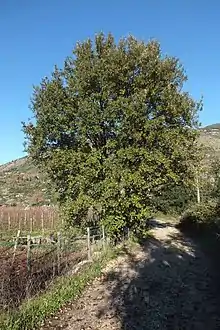Quercus × crenata
Quercus × crenata is a tree in the family Fagaceae. It is treated as a hybrid between the European trees Turkey oak (Quercus cerris) and cork oak (Quercus suber)[2] but may also represent a distinct species.[3] In the past, it has often been called Quercus × hispanica, a name that properly refers to presumed hybrids between Portuguese oak (Quercus faginea) and Quercus suber.[4]
| Quercus × crenata | |
|---|---|
 | |
| Scientific classification | |
| Kingdom: | Plantae |
| Clade: | Tracheophytes |
| Clade: | Angiosperms |
| Clade: | Eudicots |
| Clade: | Rosids |
| Order: | Fagales |
| Family: | Fagaceae |
| Genus: | Quercus |
| Subgenus: | Quercus subg. Cerris |
| Section: | Quercus sect. Cerris |
| Species: | Q. × crenata |
| Binomial name | |
| Quercus × crenata | |
| Synonyms[1] | |
|
Quercus × hispanica Lam. | |
Distribution
Hybridisation occurs naturally in southwestern Europe where both parent species occur.[5] The Lucombe oak cultivar (Q. × crenata 'Lucombeana') is frequently found in British collections. To be a true Lucombe oak, cultivars must be clones of the original hybrid arising in William Lucombe's Exeter nursery.[6] "Lucombeana' has received the Royal Horticultural Society's Award of Garden Merit.[7]
Cultivation
A number of named cultivars are grown in gardens, parks, arboreta and botanical gardens.
Cultivars
- Quercus × crenata 'Lucombeana' ("Lucombe oak"), originally raised by William Lucombe at his Exeter, UK nursery in 1762. An early Lucombe Oak is in Kew Gardens arboretum, and is regarded as one of their 'heritage trees'.[8] The Tree Register of the British Isles−TROBI Champion is at Phear Park in Exmouth, measuring 26 metres (85 ft) in height, with a trunk diameter of 261 centimetres (103 in) in 2008.[9]
- Quercus × crenata 'Waasland' ("Waasland select oak"), leaves display an unusual slender, lobed shape.[10]
- Quercus × crenata 'Wageningen' ("Wageningen oak")[11]
- Quercus × crenata 'Fulhamensis' ("Fulham oak")
References
- "Quercus crenata Lam.". World Checklist of Selected Plant Families. Royal Botanic Gardens, Kew – via The Plant List. Note that this website has been superseded by World Flora Online
- Conte, L.; Cotti, C.; Cristofolini, G. (2007). "Molecular evidence for hybrid origin of Quercus crenata Lam. (Fagaceae) from Q. cerris L. and Q. suber L.". Plant Biosystems. 141 (2): 181–193. doi:10.1080/11263500701401463. S2CID 83882998.
- Simeone, Marco Cosimo; Cardoni, Simone; Piredda, Roberta; Imperatori, Francesca; Avishai, Michael; Grimm, Guido W.; Denk, Thomas (2018). "Comparative systematics and phylogeography of Quercus Section Cerris in western Eurasia: inferences from plastid and nuclear DNA variation". PeerJ. 6: e5793. doi:10.7717/peerj.5793. ISSN 2167-8359. PMC 6195796. PMID 30356975.
- Vázquez Pardo, F.M.; Coombes, A.J.; García Alonso, D.; Márquez García, F.; Rodrigues Meireles, C.; Guerra Barrena, M.J.; Vila-Viçosa, C. (2018). "Anotaciones a la nomenclatura del género Quercus L., (FAGACEAE) en la Península Ibérica y NW de África". Fol. Bot. Extremadurensis. 12: 5–79.
- Johnson, O. & More, D. (2004), Collins Tree Guide - The Most Complete Field Guide to the Trees of Britain and Europe, Collins, p. 220, ISBN 978-0-00720771-8
- "'Lucombeana' Lucombe Oak". treesandshrubsonline.org. Retrieved 28 August 2018.
- "Quercus × crenata 'Lucombeana'". RHS. Retrieved 17 February 2021.
- "About Kew's Arboretum". kew.org. Retrieved 28 August 2018.
- Johnson, O. (2011), Champion Trees of Britain & Ireland, Kew Publishing, London, p. 142, ISBN 978-1842464526
- "Quercus x crenata 'Waasland'". ornamental-trees.co.uk. Retrieved 28 August 2018.
- "Quercus x crenata 'Wageningen'". majestictrees.co.uk. Retrieved 28 August 2018.